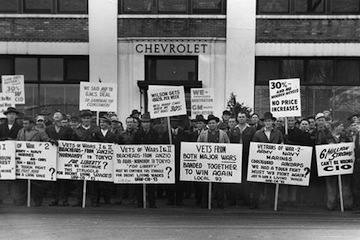The Postwar Strike Wave of 1945-46
When people look back to the postwar era in the United States, they commonly envision an era of prosperity and social conformity. To an extent this is true -- economic growth was steady between 1945 and 1970, and by outward appearances a certain social cohesion was evident. But such a clear line of progress is easier to impose in retrospect than it was to see at the time. For in the wake of World War II, many people feared a return of the Depression, and the huge strikes, inflation, and labor disorder of 1945-46 did little to assuage those fears.
This era saw a huge influx of workers into the labor force. Over 10 million soldiers were discharged from the military between 1945 and 1947. At the same time, many millions of union members had worked in war industries during World War II. Their unions had put off any major demands for the sake of national unity. Once Japan surrendered, these demands resurfaced and led to the largest series of labor actions in American history. Over five million workers were involved in a strike during the first year after World War II.
The first big strike occurred among the oil workers, less than a month after Japan's surrender. Hours remained at their elevated wartime levels, without pay increases, and 43,000 workers went on strike. In October, Harry Truman ordered the Navy to seize many of the refineries and for the workers to return. This episode was just a footnote compared to what followed. In November the United Auto Workers struck against General Motors for 113 days. Walter Reuther led 320,000 workers and won a 17.5% pay increase.
By 1946, strikes proliferated to the point that a national crisis was at hand. Electrical workers, meatpackers, lumber men, teamsters, and steelworkers all had their labor actions. Rochester and Pittsburgh saw general strikes take hold. In December 1946, Oakland, California would witness a general strike in which over 100,000 stopped working.
The most infamous incidents, however, occurred in early 1946. First, Harry Truman faced off with the United Mine Workers (UMW), and shortly thereafter with the nation's railroad workers. The UMW was led by John L. Lewis, a man who'd worked in the mines as a teenager and dedicated his life to the mineworkers thereafter. In March 1946 he led 350,000 of them into a coal strike. Shortly thereafter, the two largest railroad unions also struck. While Truman generally supported labor, he also feared an end to the postwar recovery and a crippling of European aid and his political prospects. He ordered the federal government to sieze the affected coal mines until a settlement was reached, and threatened to draft striking rail workers into the U.S. Army.
Many of the strikes, however, did lead to some concessions. Numerous unions won wage increases, and real wages throughout the U.S. generally rose in the years after World War II. So too did prices. The official inflation rate was 8% in 1946, 14% in 1947, and 8% again in 1948. This was a stressful development for those who, for whatever reason, did not see their incomes increase accordingly.
The strikes did not win support from the majority of Americans. In the 1946 Congressional Elections, the Republican Party gained 55 seats and control of the House for the first time since 1930. Conservative sentiment in the U.S. was galvanized by opposition to the strikes while liberals were divided by the actions of Truman. Many people on the left were furious about Truman's interventions. In 1948 this sentiment drove support to Henry Wallace of the Progressive Party.
The Republicans used their majority to pass the Taft-Hartley Act over Truman's veto. This law prohibited many kinds of strikes and allowed states to pass right-to-work laws. It prohibited closed shops (i.e., where new workers must be in a given union to be hired). It required union leaders to declare to the U.S. Department of Labor that they were not communists. Truman redeemed himself with much of the labor movement by opposing the bill, but was unsuccessful in getting it repealed.
The more stable economic environment of the 1950s has become associated with the postwar memory, but people living through the first years after World War II would hardly of thought their era was a time of political consensus and friendly cooperation. In many ways, it seems this is an impression that has been imposed with the benefit of hindsight.
